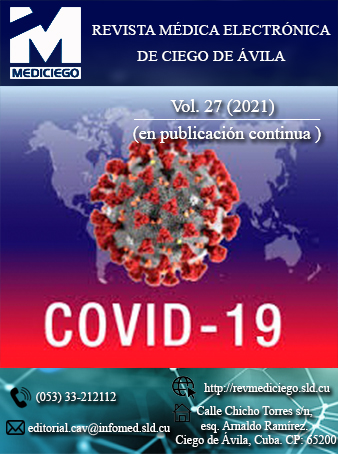Effectiveness of HeberFERON® in the treatment of basal cell carcinoma of the back of the nose
Abstract
Introduction: basal cell carcinoma is the most common cause of neoplasms, without distinction between racial groups, ethnic groups or ages.
Objective: to evaluate the effectiveness of HeberFERON® for the treatment of basal cell carcinoma of the back of the nose.
Methods: a pre-experimental study of the before and after type was carried out at the Ciego de Ávila Provincial General Teaching Hospital, in the period July 2017 to April 2019. It worked with the 32 adults who met the inclusion criteria. Two treatment schemes were applied with different doses and ways of administration. Chi-square, Mann-Whitney's U, and Cochran's Q tests were used. Ethical principles were met.
Results: the general mean age was 70 years (DT =16,0) with a predominance of males (59,40 %), urban origin (56,25 %), skin phenotype II (53,10 %), the clinical form and nodular dermatological pattern, and erythema as an adverse event. The complete clinical response was observed in all histological forms and patterns, with a predominance of the nodular. The frequency of applications was associated with the complete clinical response. Telangiectasia was the most commonly observed dermoscopic finding (100 %). Only one patient presented partial persistence of the injury to the second year, unrelated to the number or type of injury.
Conclusions: the therapeutic effectiveness of HeberFERON® was demonstrated in patients with basal cell carcinoma of the back of the nose. In all clinical forms and histological patterns studied, the complete clinical response, safety and tolerability were goodDownloads
Published
How to Cite
Issue
Section
License
Those authors who have publications with this journal accept the following terms of the License CC Attribution-NonCommercial 4.0 International (CC BY-NC 4.0):
You are free to:
- Share — copy and redistribute the material in any medium or format
- Adapt — remix, transform, and build upon the material
The licensor cannot revoke these freedoms as long as you follow the license terms.
Under the following terms:
- Attribution — You must give appropriate credit , provide a link to the license, and indicate if changes were made . You may do so in any reasonable manner, but not in any way that suggests the licensor endorses you or your use.
- NonCommercial — You may not use the material for commercial purposes .
- No additional restrictions — You may not apply legal terms or technological measures that legally restrict others from doing anything the license permits.
The journal is not responsible for the opinions and concepts expressed in the works, which are the exclusive responsibility of the authors. The Editor, with the assistance of the Editorial Committee, reserves the right to suggest or request advisable or necessary modifications. Original scientific works are accepted for publication, as are the results of research of interest that have not been published or sent to another journal for the same purpose.
The mention of trademarks of specific equipment, instruments or materials is for identification purposes, and there is no promotional commitment in relation to them, neither by the authors nor by the editor.

























